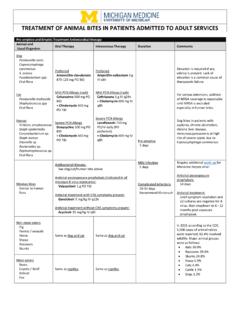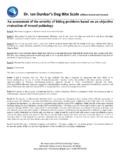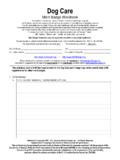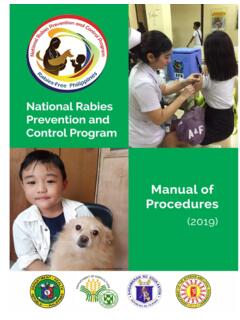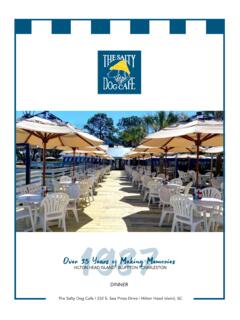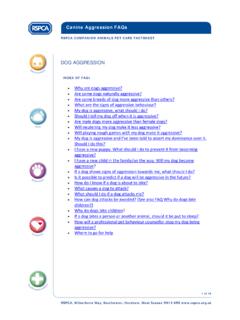Transcription of Biting, Nipping & Jumping Up - Do It Yourself Dog Training ...
1 PREVENTING THOSE BAD. BEHAVIORS . Biting, Nipping & Jumping Up Stopping Dog Biting and Nipping THE PROBLEM WITH PUPPY AND. DOG AGGRESSION. Probably the most challenging aspect of working with aggression in dogs is that it often starts when the dog is a puppy. The behavior, when the puppy is small, is often considered rather cute. A tiny little puppy growling ferociously or chasing and Nipping may appear to be almost comical but once the dog is full grown, even with small breeds, the Nipping is no longer funny and the cute growling has turned taking the dog out in public into an embarrassing and stressful event.
2 Even simple things like Jumping up become a problem as the puppy matures. A. small dog Jumping up may not be frightening, but a large Labrador or German Shepard Jumping up can be a hazard to children and the elderly, plus a nuisance for everyone else. Controlling a dog's aggressive behavior is a challenging for most people. It is further complicated by the fact that some dogs are more dominant than their owners, or a least more dominant than some family members. Thankfully even young children can be taught to properly respond to aggressive behaviors with the family pet and the dog will quickly learn to change their negative behavior into something more positive and acceptable.
3 This booklet will provide positive, non-punishment based ways to address the following aggressive behaviors in dogs: Nipping Biting Aggressive play Jumping up Each one of these behaviors can be eliminated from your dog's behavior by following some basic dog psychology tips and working with your pets natural instincts, rather than against them. If you have several people working with the dog be sure they are all using the same techniques. A great idea is to have one person work with the dog initially and then involve other family members as the Training progresses.
4 Consistency will only increase the dog's ability to understand the changes that you are expecting. 2006 -2007. Vinayak Enterprises Pty Ltd. 2. Stopping Dog Biting and Nipping STOPPING Nipping AND BITING. Dogs nip and bite for a variety of reasons. In interactions between dogs Nipping and biting is a way to for one dog or puppy to indicate they don't like what is going on. It is a way for puppies and dogs to say Stop to each other. As dogs mature they may nip for other reasons including demanding attention, avoiding something they don't want to do, or becoming excited or frightened.
5 Each type of Nipping and biting will require a different type of correction and understanding why your dog is Nipping is a starting point. Think about the times that your dog has nipped. Answer the following questions: 1. What was the dog or puppy doing? 2. What was I doing (or the person that was nipped)? 3. Was the dog in a new environment or with new people? 4. How did I respond to the Nipping ? 5. How did the dog respond? 6. What happened after the dog nipped? BITING FOR ATTENTION OR IN PLAY. Dog and puppies may have learned that biting or Nipping gets them attention or that is all part of the game.
6 This may be true for smaller breeds that nip or bite and their owner picks them up and holds them, or for puppies when the game continues even after someone is nipped or bitten. Some owners may try to pay additional attention to a dog that nips to keep it from Nipping or biting them again. In this situation the dog has trained the human, not the other way around. Depending on how long the dog or puppy has engaged in biting or Nipping , the corrective Training may be very short or it may take longer. Usually attention and play type biting is more prevalent with puppies that are learning how to interact with humans.
7 To stop the attention and play biting follow these guidelines: Give a sharp, high pitched Ouch , Stop or Ow then No Bite in a lower tone, without yelling or verbally intimidating the dog or puppy 2006 -2007. Vinayak Enterprises Pty Ltd. 3. Stopping Dog Biting and Nipping Immediately leave the puppy or dog alone, don't speak to them or touch them at all If the puppy or dog continues to try to bite after you give the verbal No Bite try putting a few pennies or marbles in a clean tin can. Shake the can at the dog or puppy immediately after the No Bite command.
8 This will usually startle the dog or puppy and will reinforce the verbal instruction. If the bite or nip occurred during a game immediately stop the game and do not continue until the dog is calm and in control. When they are calm, immediately provide attention and praise. Most puppies and dogs will respond to this Training when they realize that they get attention and fun when they are not biting or are practicing what dog trainers call bite inhibition . BITING FOR FEAR OR ANXIETY. If a dog bites when in new places or when new people are present it is likely a nervous or fearful dog.
9 How to stop a dog from biting that is behaving aggressively out of fear is very different from the technique used for the attention seeking or Nipping dog. Dogs that are nervous or fearful need additional socialization, not isolation or being ignored. Ideally socialization should occur in the first few months of a puppy's life and continue throughout the dog's life. Dogs that are kept isolated from other dogs, animals, people and new environments are naturally more fearful and self-protective when they are exposed to new things. A dog's natural defense is to bite or run so when you are out with your dog on a leash the only option the dog has to protect itself is to bite.
10 One of the best ways to work with a dog that bites from fear or anxiety is to take him or her to an obedience class. It is very important that you speak to the trainer ahead of time and follow the instructions that the trainer provides for bringing your dog into the class. Try taking your dog to as many new places as possible, but watch for signs that he or she is becoming agitated or fearful. Nervous behaviors such as the following should be monitored: Tail low or tucked between the hind legs Whining or growling Pacing Excessive panting When the dog starts exhibiting these symptoms immediately remove him or her from the environment and place him/her somewhere comfortable such as the vehicle or their crate.
